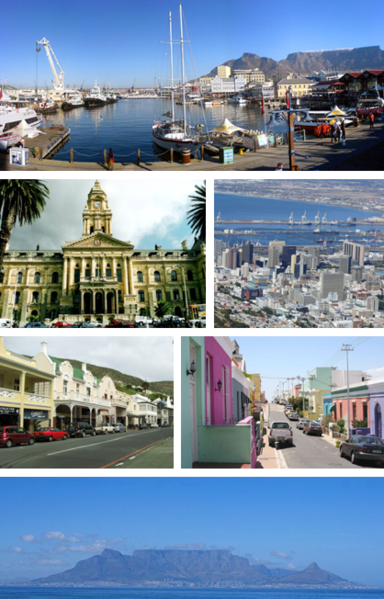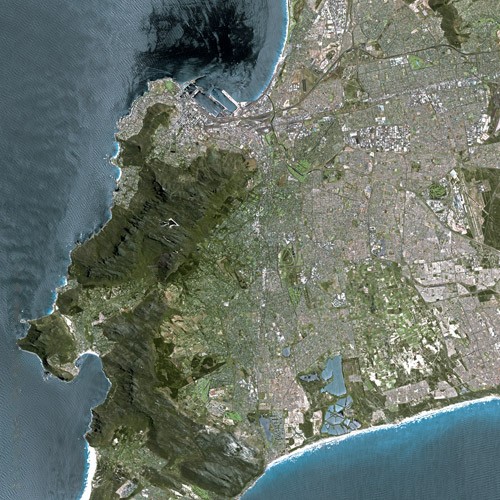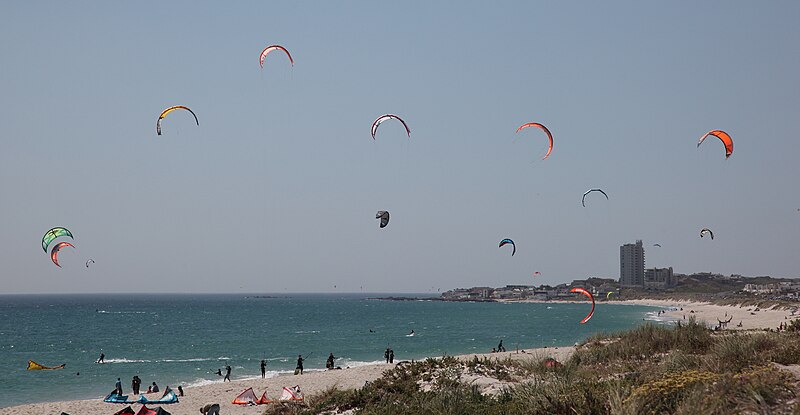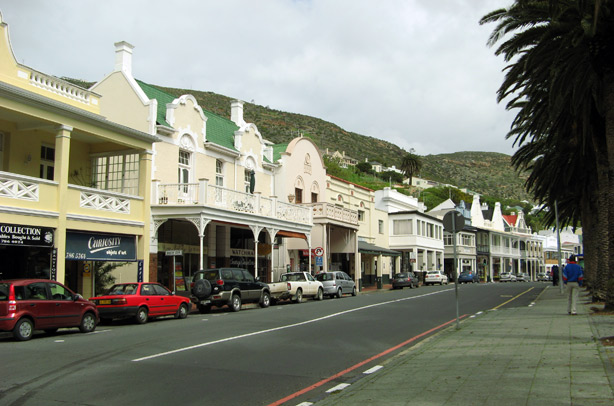 Cape Town (Afrikaans: Kaapstad; Xhosa: iKapa) is the second-most populous city in South Africa, and the provincial capital and primate city of the Western Cape. As the seat of the National Parliament, it is also the legislative capital of the country. It forms part of the City of Cape Town metropolitan municipality. The city is famous for its harbour as well as its natural setting in the Cape floral kingdom, including such well-known landmarks as Table Mountain and Cape Point. Cape Town is also Africa's most popular tourist destination.
Cape Town (Afrikaans: Kaapstad; Xhosa: iKapa) is the second-most populous city in South Africa, and the provincial capital and primate city of the Western Cape. As the seat of the National Parliament, it is also the legislative capital of the country. It forms part of the City of Cape Town metropolitan municipality. The city is famous for its harbour as well as its natural setting in the Cape floral kingdom, including such well-known landmarks as Table Mountain and Cape Point. Cape Town is also Africa's most popular tourist destination.Located on the shore of Table Bay, Cape Town was originally developed by the Dutch East India Company as a victualling (supply) station for Dutch ships sailing to Eastern Africa, India, and the Far East. Jan van Riebeeck's arrival on 6 April 1652 established the first permanent European settlement in South Africa. Cape Town quickly outgrew its original purpose as the first European outpost at the Castle of Good Hope, becoming the economic and cultural hub of the Cape Colony. Until the Witwatersrand Gold Rush and the development of Johannesburg, Cape Town was the largest city in South Africa.

Today it is one of the most multicultural cities in the world, reflecting its role as a major destination for immigrants and expatriates to South Africa. As of 2007 the city had an estimated population of 3.5 million.Cape Town's land area of 2,455 square kilometres (948 sq mi) is larger than other South African cities, resulting in a comparatively lower population density of 1,425 inhabitants per square kilometre (3,690 /sq mi).
The city was named the World Design Capital for 2014 by the International Council of Societies of Industrial Design.

History
There is no certainty as to when humans first occupied the area prior to the first visits of Europeans in the 15th century. The earliest known remnants in the region were found at Peers cave in Fish Hoek and date to between 15,000 and 12,000 years ago. Little is known of the history of the region's first residents, since there is no written history from the area before it was first mentioned by Portuguese explorer Bartolomeu Dias in 1486. Vasco da Gama recorded a sighting of the Cape of Good Hope in 1497. In the late 16th century, Portuguese, French, Danish, Dutch and English ships regularly stopped over in Table Bay en route to the Indies. They traded tobacco, copper and iron with the Khoikhoi in exchange for fresh meat. In 1652, Jan van Riebeeck and other employees of the Dutch East India Company (Dutch: Verenigde Oost-indische Compagnie, VOC) were sent to the Cape to establish a way-station for ships travelling to the Dutch East Indies, and the Fort de Goede Hoop (later replaced by the Castle of Good Hope). The settlement grew slowly during this period, as it was hard to find adequate labour. This labour shortage prompted the authorities to import slaves from Indonesia and Madagascar. Many of these became ancestors of the first Cape Coloured communities. Under Van Riebeeck and his successors as VOC commanders and later governors at the Cape, an impressive range of useful plants were introduced to the Cape – in the process changing the natural environment forever. Some of these, including grapes, cereals, ground nuts, potatoes, apples and citrus, had an important and lasting influence on the societies and economies of the region.
During the French Revolutionary and Napoleonic wars, the Netherlands was repeatedly occupied by France, and Great Britain moved to take control of Dutch colonies. Britain captured Cape Town in 1795, but the Cape was returned to the Netherlands by treaty in 1803. British forces occupied the Cape again in 1806 following the battle of Bloubergstrand. In the Anglo-Dutch Treaty of 1814, Cape Town was permanently ceded to Britain. It became the capital of the newly formed Cape Colony, whose territory expanded very substantially through the 1800s.

The discovery of diamonds in Griqualand West in 1867, and the Witwatersrand Gold Rush in 1886, prompted a flood of immigrants to South Africa.[citation needed] Conflicts between the Boer republics in the interior and the British colonial government resulted in the Second Boer War of 1899–1902, which Britain won. In 1910, Britain established the Union of South Africa, which unified the Cape Colony with the two defeated Boer Republics and the British colony of Natal. Cape Town became the legislative capital of the Union, and later of the Republic of South Africa.

Nobel Square at the Victoria & Alfred Waterfront.
In the 1948 national elections, the National Party won on a platform of apartheid (racial segregation) under the slogan of "swart gevaar". This led to the Group Areas Act, which classified all areas according to race. Formerly multi-racial suburbs of Cape Town were either purged of unlawful residents or demolished. The most infamous example of this in Cape Town was District Six. After it was declared a whites-only region in 1965, all housing there was demolished and over 60,000 residents were forcibly removed. Many of these residents were relocated to the Cape Flats and Lavender Hill. Under apartheid, the Cape was considered a "Coloured labour preference area", to the exclusion of "Bantus", i.e. blacks.
Cape Town was home to many leaders of the anti-apartheid movement. On Robben Island, a former penitentiary island 10-kilometres from the city, many famous political prisoners were held for years. In one of the most famous moments marking the end of apartheid, Nelson Mandela made his first public speech in decades on 11 February 1990 from the balcony of Cape Town City Hall hours after being released. His speech heralded the beginning of a new era for the country, and the first democratic election was held four years later, on 27 April 1994. Nobel Square in the Victoria & Alfred Waterfront features statues of South Africa's four Nobel Peace Prize winners – Albert Luthuli, Desmond Tutu, F. W. de Klerk and Nelson Mandela. Since 1994, the city has struggled with problems such as HIV/AIDS, tuberculosis, a surge in violent drug-related crime and more recent xenophobic violence. At the same time, the economy has surged to unprecedented levels due to the boom in the tourism and the real estate industries
Tourism
Cape Town is not only the most popular international tourist destination in South Africa, but Africa as a whole. This is due to its good climate, natural setting, and well-developed infrastructure. The city has several well-known natural features that attract tourists, most notably Table Mountain, which forms a large part of the Table Mountain National Park and is the back end of the City Bowl. Reaching the top of the mountain can be achieved either by hiking up, or by taking the Table Mountain Cableway. Cape Point is recognised as the dramatic headland at the end of the Cape Peninsula. Many tourists also drive along Chapman's Peak Drive, a narrow road that links Noordhoek with Hout Bay, for the views of the Atlantic Ocean and nearby mountains. It is possible to either drive or hike up Signal Hill for closer views of the City Bowl and Table Mountain.Many tourists also visit Cape Town's beaches, which are popular with local residents. Due to the city's unique geography, it is possible to visit several different beaches in the same day, each with a different setting and atmosphere. Though the Cape's water ranges from cold to mild, the difference between the two sides of the city is dramatic. While the Atlantic Seaboard averages annual water temperatures barely above that of coastal California around 13 °C (55 °F), the False Bay coast is very much warmer, averaging between 16 and 17 °C (61 and 63 °F) annually. This is similar to water temperatures in much of the Northern Mediterranean (for example Nice). In Summer, False bay water averages slightly over 20 °C (68 °F), with 22 °C (72 °F) a common high. Beaches located on the Atlantic Coast tend to have very cold water due to the Benguela current which originates from the Southern Ocean, whilst the water at False Bay beaches may be warmer by up to 10 °C (18 °F) at the same moment due to the influence of the warm Agulhas current, and the surface warming effects of the South Easter wind.

Both coasts are equally popular, although the beaches in affluent Clifton and elsewhere on the Atlantic Coast are better developed with restaurants and cafés, with a particularly vibrant strip of restaurants and bars accessible to the beach at Camps Bay. Boulders Beach near Simon's Town is known for its colony of African Penguins. Surfing is popular and the city hosts the Red Bull Big Wave Africa surfing competition every year.
The city has several notable cultural attractions. The Victoria & Alfred Waterfront, built on top of part of the docks of the Port of Cape Town, is the city's most visited tourist attraction. It is also one of the city's most popular shopping venues, with several hundred shops and the Two Oceans Aquarium. Part of the charm of the V&A, as it is locally known, is that the Port continues to operate and visitors can watch ships enter and leave. The V&A also hosts the Nelson Mandela Gateway, through which ferries depart for Robben Island. It is possible to take a ferry from the V&A to Hout Bay, Simon's Town and the Cape Fur Seal colonies on Seal and Duiker Islands. Several companies offer tours of the Cape Flats, a mostly Coloured township, and Khayelitsha, a mostly black township. An option is to sleep overnight in Cape Town's townships. There are several B&Bs where you can spend a safe and real African night.

Cape Town is noted for its architectural heritage, with the highest density of Cape Dutch style buildings in the world. Cape Dutch style, which combines the architectural traditions of the Netherlands, Germany, France and Indonesia, is most visible in Constantia, the old government buildings in the Central Business District, and along Long Street.The annual Cape Town Minstrel Carnival, also known by its Afrikaans name of Kaapse Klopse, is a large minstrel festival held annually on 2 January or "Tweede Nuwe Jaar" (Afrikaans: Second New Year). Competing teams of minstrels parade in brightly coloured costumes, performing Cape Jazz, either carrying colourful umbrellas or playing an array of musical instruments. The Artscape Theatre Centre is the main performing arts venue in Cape Town.

The city also encloses the 36 hectare Kirstenbosch National Botanical Garden that contains protected natural forest and fynbos along with a variety of animals and birds. There are over 7000 species in cultivation at Kirstenbosch, including many rare and threatened species of the Cape Floristic Region. In 2004 this Region, including Kirstenbosch, was declared a UNESCO World Heritage Site.
Cape Town's transport system links it to the rest of South Africa; it serves as the gateway to other destinations within the province. The Cape Winelands and in particular the towns of Stellenbosch, Paarl and Franschhoek are popular day trips from the city for sightseeing and wine tasting. Whale watching is popular amongst tourists: Southern Right Whales and Humpback Whales are seen off the coast during the breeding season (August to November) and Bryde's Whales and Killer Whale can be seen any time of the year.The nearby town of Hermanus is known for its Whale Festival, but whales can also be seen in False Bay. Heaviside's dolphins are endemic to the area and can be seen from the coast north of Cape Town; Dusky dolphins live along the same coast and can occasionally be seen from the ferry to Robben Island.

The only complete windmill in South Africa is Mostert's Mill, Mowbray. It was built in 1796 and restored in 1935 and again in 1995. The mill is open to the public on one Saturday a month.
Approximately 1.5 million tourists visited in Cape Town during 2004, bringing in a total of R10 billion in revenue. The forecasts for 2006 anticipate 1.6 million tourists spending a total of R12 billion.[who?] The most popular areas for visitors to stay include Camps Bay, Sea Point, the V&A Waterfront, the City Bowl, Hout Bay, Constantia, Rondebosch, Newlands, Somerset West, Hermanus and Stellenbosch, as well.
The total accommodation capacity in Cape Town currently stands at close to 60,000 beds (29, 800 rooms) in 2690 establishments, the highest of all South African cities.

Transport
Air

Map showing flights from Cape Town International Airport to destinations outside Southern Africa.
Cape Town International Airport serves both domestic and international flights. It is the second-largest airport in South Africa and serves as a major gateway for travellers to the Cape region. Cape Town has direct flights to most cities in South Africa as well as a number of international destinations.
Cape Town International Airport recently opened a brand new central terminal building that was developed to handle an expected increase in air traffic as tourism numbers will increase in the lead-up to the 2010 FIFA World Cup. Other renovations include several large new parking garages, a revamped domestic departure terminal, a new Bus Rapid Transit system station and a new double-decker road system. The airport's cargo facilities are also being expanded and several large empty lots are being developed into office space and hotels.
The Cape Town International Airport was among the winners of the World Travel Awards for being Africa's leading airport.
Sea

Table Mountain from the Harbour.
Cape Town has a long tradition as a port city. The Port of Cape Town, the city's main port, is located in Table Bay directly to the north of the central business district. The port is a hub for ships in the southern Atlantic: it is located along one of the busiest shipping corridors in the world. It is also a busy container port, second in South Africa only to Durban. In 2004, it handled 3,161 ships and 9.2 million tonnes of cargo.
Simon's Town Harbour on the False Bay coast of the Cape Peninsula is the main base of the South African
Navy.
The Port of Cape Town (specifically the V&A Waterfront) made headlines worldwide during 2009 when plans to berth the iconic liner QE2 were announced.
Rail

A Metrorail train leaving Kalk Bay station
The Shosholoza Meyl is the passenger rail operations of Spoornet and operates two long-distance passenger rail services from Cape Town: a daily service to and from Johannesburg via Kimberley and a weekly service to and from Durban via Kimberley, Bloemfontein and Pietermaritzburg. These trains terminate at Cape Town railway station and make a brief stop at Bellville. Cape Town is also one terminus of the luxury tourist-oriented Blue Train as well as the five-star Rovos Rail.
Metrorail operates a commuter rail service in Cape Town and the surrounding area. The Metrorail network consists of 96 stations throughout the suburbs and outskirts of Cape Town.
Road

The N2, also known as the Nelson Mandela Boulevard (prev. Eastern Boulevard), as it enters the City Bowl and ends in the Central Business District
Three national roads start in Cape Town: the N1 which links Cape Town with Bloemfontein, Johannesburg, Pretoria and Zimbabwe; the N2 which links Cape Town with Port Elizabeth, East London and Durban; and the N7 which links Cape Town with the Northern Cape Province and Namibia. The N1 and N2 both start in the Central Business District, and split to the east of the CBD, with the N1 continuing to the north east and the N2 heading south east past Cape Town International Airport. The N7 starts in Mitchells Plain and runs north, intersecting with the N1 and the N2 before leaving the city.
Cape Town also has a system of freeway and dual carriageway M-roads, which connect different parts of the city. The M3 splits from the N2 and runs to the south along the eastern slopes of Table Mountain, connecting the City Bowl with Muizenberg. The M5 splits from the N1 further east than the M3, and links the Cape Flats to the CBD. The R300, which is informally known as the Cape Flats Freeway, links Mitchells Plain with Bellville, the N1 and the N2.
Buses

Golden Arrow Bus Services operates scheduled bus services throughout the Cape Town metropolitan area. Several companies run long-distance bus services from Cape Town to the other cities in South Africa.
Integrated Rapid Transit
Cape Town has embarked on Phase 1 of the IRT system with a total investment of close to R5 billion. Phase 1 will include a West Coast Service, Inner City Service and Airport Link. A 2010 Starter service to meet the requirements for the FIFA World Cup will include an Inner City Service, Stadium Shuttle and Airport Service. A total of 43 IRT Volvo buses have been ordered and are expected to be delivered during April and May.
Taxis

Cape Town taxi rank above train station
Cape Town has two kinds of taxis: metered taxis and minibus taxis. Unlike many cities, metered taxis are not allowed to drive around the city to solicit fares and instead must be called to a specific location.
Minibus taxis are the standard form of transport for the majority of the population who cannot afford private vehicles.Although essential, these taxis are often poorly maintained and are frequently not road-worthy. These taxis make frequent unscheduled stops to pick up passengers, which can cause accidents. With the high demand for transport by the working class of South Africa, minibus taxis are often filled over their legal passenger allowance, making for high casualty rates when minibuses are involved in accidents. Minibuses are generally owned and operated in fleets, and inter-operator violence flares up from time to time, especially as turf wars occur over lucrative taxi routes.

No comments:
Post a Comment